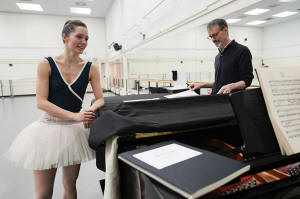Fluttering arms, aching calves, bursting lungs: 'Swan Lake' is a
ballerina's Mount Everest
[March 13, 2025]
By JOCELYN NOVECK
NEW YORK (AP) — Rehearsing “Swan Lake” a few weeks ago in a sweaty
studio, trying to iron out some last-minute kinks, ballerina Unity
Phelan stopped just before launching into the famed 32 fouettés — those
crowd-pleasing whiplash turns on one leg performed by Odile, the devious
Black Swan.
“No fouettés today — save them for tonight,” directed Phelan’s coach at
New York City Ballet, Kathleen Tracey. Dancer and coach agreed:
preserving Phelan’s precious leg muscles took priority over rehearsing
the fiendishly difficult move.
Phelan was a few hours away from performing the dual role of Odette and
Odile for the second time, four days after her debut. It's a goal she'd
had since childhood. Achieving it at age 30 was a bucket-list moment
like no other — witnessed by friends, family, “all of New Jersey” (her
home state) and a few thousand others.
It was also probably the most physically challenging feat of her career.
Many across the world know “Swan Lake,” the most iconic of all ballets.
Far fewer know just how hard the main ballerina role is to perform. As
graceful and ephemeral as it appears, Odette-Odile is a dancer's Mount
Everest, requiring stellar technique, prodigious training, uncommon
stamina, emotional resilience — and even carbo-loading.
The ballerina dances virtually nonstop for 2 ½ hours, with a quick
intermission for refueling. The toughest part comes toward the end —
when she's most tired, of course — with trickster Odile unleashing a
dazzling display as she misleads the prince in a tragedy of mistaken
identity. Even before she gets to the dastardly fouettés — the word
means “whipped” in French — the dancer has to huff and puff just to make
the entrance.

There's “hardly enough time to get to the back wing, and then you’re
back out,” Phelan explains. “You’re so exhausted and you have to run
back out and keep going.” So exhausted that at dress rehearsal, she
remarked to another dancer as she raced to her entrance: “Man, I’m
questioning all my life choices right now!”
She was kidding, of course. Phelan was one of three lucky NYCB
ballerinas tapped to debut the role this past season, a new generation
of swan queens discovering the ecstasy and the agony in one of ballet's
toughest gigs.
You can’t give up on yourself
For Mira Nadon, swan queen glory has arrived early, at 23. The
fast-rising ballet star became a principal dancer in 2023, the first
Asian American female principal in the company. Her wunderkind
reputation was only enhanced with her debut as Odette-Odile this season,
which had many in the audience marveling at her technique and artistry.
Nadon, like Phelan, says the role was always her dream — not that she
thought it would come so soon.
“Of all the full-length ballets,” Nadon said in an interview, “this is
the one that I most identify with, and really hoped to get to do one
day.”
Even in the rarefied air of being a principal at a top company, it’s not
a given that you get to dance a role like this. NYCB ballerina Sara
Mearns famously got the part at 19, when she was still in the corps de
ballet, and continued to dance it this season, along with fellow
longtime star Tiler Peck. But many never get the chance. The last time
the company ran its full-length “Swan Lake, choreographed by Peter
Martins, was five years ago, just before the outbreak of the coronavirus
pandemic. A later run was canceled due to COVID-19 concerns.
So Nadon was thrilled when she was told in the fall that she'd be
donning the swan feathers. During the busy “Nutcracker” run over the
holidays, she began working with her coach, Rebecca Krohn, to learn the
steps and “have them settle into my body.” It is that muscle memory,
dancers say, that often saves them when things are tough. And like any
athlete, Nadon spent the season building up stamina so that it would be
at peak form for “Swan Lake.”

[to top of second column]
|

Unity Phelan, left, takes a break during a rehearsal for her role as
Swan Queen in New York City Ballet's "Swan Lake," Tuesday, Feb. 25,
2025, in New York. (AP Photo/Julia Demaree Nikhinson)
 Even so, the role was a challenge.
“You have to accept that you will be tired, and you just have to
push through it and trust yourself,” she says. “Because when you
have something that is so taxing, it’s a little bit mental. You
can’t give up on yourself. You have to really believe that you can
do it.”
Your mind wants you to stop
It was that very self-belief that Miriam Miller says she had to
fight for.
“I kind of thought it was off the table, like I wasn’t really going
down that route,” says Miller, 28, who became a principal just weeks
before her “Swan Lake” debut. She said she never saw herself as a
great turner, or able to master some of the Black Swan’s tricky
footwork.
“It has every single ballet step in the book,” Miller says of the
iconic ballet. “In White Swan, it’s so delicate and we strive to be
perfectly placed and thoughtful about all the in-between steps … so
that takes a different effort,” she says. “Then you have 25 minutes
(for intermission), you have to do a quick change, you have to
change your shoes, you have to eat, you have to just kind of reset.”
And that’s just the physical part.
“It takes a lot of mental strength and self-awareness,” Miller adds.
“You’re fully depleting yourself in every single way.”
Somehow, she triumphed over her own doubts, and sounded exhilarated
the morning after her debut, despite the throbbing muscles.
“It’s hard sometimes to go out onstage and not let your mind take
over,” Miller says. “Our bodies are inherently lazy and our mind is
also lazy, and so it wants to tell you. ‘Stop, you’re exhausted,
just give up.’ If there is something I’m proud about, it’s that I
didn’t let those thoughts interfere with the performance.”
Carbo-loading, electrolytes, bananas and protein bars
Miller laughs when hearing the anecdote that actor Natalie Portman,
prepping for her “Black Swan” movie role, subsisted on carrots and
almonds to get in ballerina shape.
In real life, dancing that role without serious fueling? “She would
have been dead on the floor,” Miller said.

To fuel her own body, Miller carbo-loaded like a marathoner and took
electrolytes and energy supplements ahead of the performance. During
the show itself, she snacked on a peanut butter protein bar and a
banana. For Nadon, it was a sandwich beforehand, then electrolytes,
yogurt and a banana during intermission.
For Phelan, it was half a banana during the break, plus packing in
carbs and protein the day before and remembering to eat well on
performance day, a marathon that began with morning class and then
rehearsal, attended as always by her cavalier King Charles spaniel,
Pippin.
“You’re nervous, so you’re not very hungry,” Phelan says. “But you
have to make sure you eat because otherwise, you won’t have anything
in you to help.”
Whatever they ate, it worked. Now, they’re left with memories like
the moment the lights went up during curtain calls and Phelan could
finally make out some faces.
“It was completely full, people were standing and I was hit with a
wave of, ‘Oh my God, there were 2,500 people watching this! And they
liked it.’”
And they're left with something else, too. Aches, everywhere.
“I've definitely never been this exhausted after a show,” quips
Miller.
All contents © copyright 2025 Associated Press. All rights reserved |